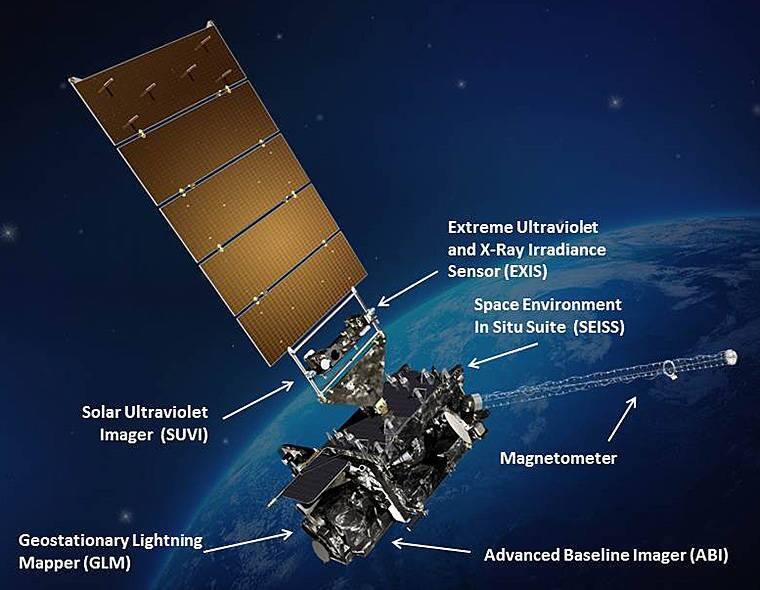On June 25, 2024, SpaceX's Falcon Heavy rocket is scheduled to launch the GOES-U mission from Kennedy Space Center's Launch Complex 39A, marking a significant milestone in the development of weather forecasting and space weather monitoring.
The GOES-U mission is the final satellite in the National Oceanic and Atmospheric Administration's (NOAA) GOES-R series of weather satellites. Designed to provide advanced imagery and atmospheric measurements of Earth's weather, oceans, and environment, GOES-U boasts real-time mapping of total lightning activity, improved monitoring of solar activity, and space weather assessment. The satellite launch, is estimated to cost approximately $152.5 million. It will have a mass of 2,800 kg (6,200 lb).

Falcon Heavy Being Prepped For GOES U Credit: SpaceX
Rocket Specifications
The SpaceX Falcon Heavy rocket is one of the world's most powerful operational rockets, comprising three reusable Falcon 9 engine cores, each equipped with 27 Merlin engines. The booster return feature enables reuse, making it a cost-effective and environmentally friendly option. Falcon Heavy has successfully launched various payloads, including NASA's Psyche satellite. This will be the 10th launch overall for this powerful rocket, designed for carrying heavy payloads into space.
Advancements and Upgrades
Compared to its predecessors (GOES-R, GOES-S, and GOES-T), GOES-U features state-of-the-art instruments for advanced imagery and atmospheric measurements. NOAA incorporated feedback from the earlier trio, resulting in improved components and enhanced capabilities. It is equipped with a Solar Ultraviolet Imager (SUVI), that gives the GOES-R series of satellites the ability to observe the sun’s solar flares and solar eruptions, which can provide early warning of possible impacts to Earth’s space environment and enable better forecasting of potentially disruptive events on the ground. The fourth satellite in NOAA’s GOES-R Series, GOES-U, recently had a new instrument installed. Called a Compact Coronagraph, this is a copy of the Naval Research Laboratory‘s Compact CORonagraph (CCOR) instrument which, along with the CCOR planned for Space Weather Follow On-Lagrange 1 (SWFO-L1), which will allow continuous monitoring of solar wind after the retirement of the NASA-ESA SOHO satellite in 2025. This will be the first time it has been installed on any GOES spacecraft.

The GOES-R satellite; GOES-U is part of the series of then four satellites. Image: NASA
Following are the mission objectives to be achieved by GOES-U:
- Advanced Imagery: GOES-U will capture incredibly detailed images of Earth’s weather systems, providing forecasters with a clearer picture of developing storms, cloud patterns, and atmospheric conditions.
- Precise Measurements: Packed with cutting-edge instruments, GOES-U will measure atmospheric pressure, temperature, and humidity with exceptional accuracy. This data is vital for weather prediction models.
- Real-time Lightning Tracking: This satellite boasts the ability to map lightning activity in real-time, allowing for better warnings and improved public safety during storms.
- Space Weather Watchdog: GOES-U will keep a watchful eye on the sun, specifically its outer atmosphere. By detecting and characterizing solar flares and coronal mass ejections, it can warn us of potential disruptions to our power grids and communication systems.
Launch Details
- Launch Date: June 25, 2024
- Launch Window: Opens at 5:16 p.m. EDT (2116 GMT)
- Launch Site: Kennedy Space Center, Florida, USA (Launch Complex 39A)
Viewing Options
Spectators near Cape Canaveral, Florida, can witness the launch from various venues, while an official live stream will be available on SpaceX’s X handle starting at 9:30 a.m. EDT (1330 GMT).
The GOES-U mission represents a significant leap forward in weather forecasting and space weather monitoring, promising to provide critical insights into Earth's weather patterns and space environment.


Add comment
Comments